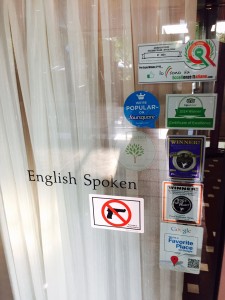
This type of signage failed to deter an attacker who opened fire on U.S. Military personnel in Chattanooga Tennessee today. While communication of policies and legal requirements can have value, schools should emphasize proven techniques to prevent acts of violence. Pattern matching and recognition has been helping to avert school shootings and other types of incidents for more than two decades.
Dealing with School Safety Threats
I had the opportunity to keynote the Campus Safety Conference in Chicago earlier this week. When a group of us went to a high-end restraint in the suburbs, I noticed a graphic notifying the public that firearms are not allowed in the restraint. While I know that many businesses post these types of signs to prevent concealed weapons permit holders from carrying guns into their establishments, I have always questioned what they do to enhance safety. Today’s attack on two U.S. military properties in Tennessee highlight the limitations of this type of signage. A similar sign is posted on the glass door of the recruiting station where one of the attacks took place. The sign clearly failed to deter the attacker from firing a number of rounds through the very door the sign was posted on. While signage relating to rules, regulations, and laws can be helpful, we must be realistic on what deterrent value they can provide.
Emphasize Proven Approaches
While we should use an array of prevention strategies, we urge our clients to focus on measures that have been proven to be effective. One strategy that has been repeatedly proven to be effective in preventing numerous tragedies on school campuses for more than two decades is pattern matching and recognition. Though this behavioral approach to awareness has been referred to by a number of names, the oldest reference to this strategy I have found thus far is pattern matching and recognition which has been used to save lives since the 1980’s. Apparently originating in an Australian cardiac care unit to help reduce patient mortality by as much as 50%, the concept is now widely utilized in military, law enforcement, emergency medicine, and a number of other high stakes settings.
How Pattern Matching and Recognition Works
Pattern matching and recognition involves people recognizing behaviors that are not typical for the context and the setting. Pattern matching and recognition can help people notice people and situations that pose potential danger ranging from bullying, medical emergencies, and a wide range of acts of violence. Because its use requires that people pay attention to others, pattern matching and recognition can help enhance school climate and connectivity while improving safety, security and emergency preparedness.
Free Video on Pattern Matching and Recognition
Safe Havens International has developed an excellent six-minute video which provides several real-life examples of how pattern matching and recognition has been used in the field. This video features an interview with a former member of the United States Army Delta Force who describes how application of this concept led to the capture of Saddam Hussein.